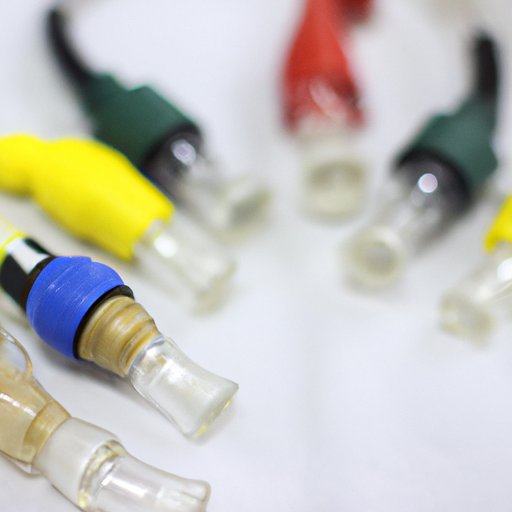
I. Introduction
Carbon dioxide (CO2) is a natural byproduct of cellular metabolism that is eliminated from the body through respiration. However, when CO2 levels in the blood exceed the normal range of 35 to 45 millimeters of mercury (mm Hg), it can lead to hypercapnia (high CO2 levels). This condition can cause headaches, confusion, shortness of breath, and in severe cases, coma or death.
The good news is that there are several ways to reduce high CO2 levels in the blood. This article outlines some lifestyle changes, breathing exercises, proper ventilation practices, medical procedures, and alternative therapies that can help lower CO2 levels and prevent potential health effects.
II. Lifestyle Changes
One of the most effective ways to maintain a healthy respiratory system and reduce CO2 levels is through lifestyle modifications. The following habits can help support lung function:
Regular Exercise
Regular physical activity can help improve respiration and reduce CO2 levels in the blood. Exercise increases the amount of oxygen taken in and carbon dioxide released during breathing. According to the American Lung Association, regular aerobic exercise like brisk walking, cycling, or swimming for 20 to 30 minutes a day, five days a week, can help maintain healthy lung function.
Healthy Eating Habits
A healthy diet rich in antioxidants, vitamins, and minerals can support lung function and reduce inflammation in the respiratory system. Include foods that are high in fiber, lean proteins, and healthy fats like fruits, vegetables, whole grains, nuts, and seeds. Avoid processed and fried foods that may cause inflammation in the lungs.
Avoid Smoking
Smoking is one of the primary causes of respiratory problems and can lead to the accumulation of CO2 in the blood. Quitting smoking or avoiding exposure to secondhand smoke can significantly improve respiratory health and reduce CO2 levels.
III. Breathing Exercises
Deep breathing exercises can help reduce CO2 levels in the blood by increasing the amount of oxygen taken in and carbon dioxide released during respiration. The following breathing exercises can help:
Diaphragmatic Breathing
Also known as belly breathing, this technique involves inhaling slowly through the nose and expanding the belly while filling the lungs with air. Exhale slowly through pursed lips and contract the belly muscles to push out any remaining air.
Pursed Lip Breathing
This technique involves inhaling through the nose and exhaling slowly through pursed lips, keeping them relaxed. This reduces the amount of air trapped in the lungs and allows for better oxygen exchange.
Alternate Nostril Breathing
This technique involves closing one nostril with your finger and inhaling through the other nostril. Hold your breath for a few seconds, then exhale through the opposite nostril. Repeat this exercise for several minutes.
Relaxation Techniques
Relaxation techniques like yoga and meditation can help promote healthy breathing habits. By reducing stress and improving relaxation, these techniques can lead to a decrease in respiratory rate and CO2 levels in the blood.
IV. Proper Ventilation
Proper ventilation can help maintain a healthy respiratory system and prevent the accumulation of CO2 in the blood. The following tips can help improve ventilation and air quality:
Ventilation Systems
Ensure that ventilation systems in homes and workplaces are functioning correctly and that the air filters are clean and regularly replaced. Proper ventilation systems remove stale air and bring in fresh air, improving the overall air quality.
Indoor Air Quality
Improve indoor air quality by keeping the area clean and removing sources of indoor air pollution such as cigarette smoke, chemical cleaners, and mold. Open windows and doors to increase airflow, especially in confined spaces where CO2 can accumulate.
V. Medical Procedures
There are various medical procedures that can help improve respiratory function and reduce CO2 levels in the blood. Some common procedures include:
Oxygen Therapy
Oxygen therapy involves breathing in pure oxygen through a mask or nasal tubes to improve oxygen levels in the blood and lower CO2 levels.
Bronchodilators
Bronchodilators are medications that open up the airways and help improve breathing. They can help reduce the amount of CO2 buildup by improving oxygen exchange.
Lung Function Tests
Lung function tests can help identify respiratory problems that may contribute to high CO2 levels in the blood. These tests measure how much air the lungs can hold, how quickly air is moved in and out of the lungs, and how efficiently oxygen is absorbed into the bloodstream.
VI. Alternative Therapies
Complementary and alternative therapies like acupuncture and naturopathy can support conventional medical treatments and promote health and well-being. These therapies can help reduce stress and inflammation, leading to improved respiratory function and lower CO2 levels in the blood.
VII. Conclusion
Reducing high CO2 levels in the blood is essential for maintaining respiratory health and preventing potential health effects. Lifestyle changes such as regular exercise, healthy eating habits, and avoiding smoking can help support lung function. Breathing exercises and proper ventilation practices can also help improve respiration and air quality. Medical procedures like oxygen therapy and bronchodilators can provide relief, while alternative therapies like acupuncture and naturopathy can support conventional treatments. It is essential to consult a doctor before attempting any alternative therapies. By incorporating these methods into daily life, individuals can help reduce CO2 levels in the blood and prevent potential health effects.




